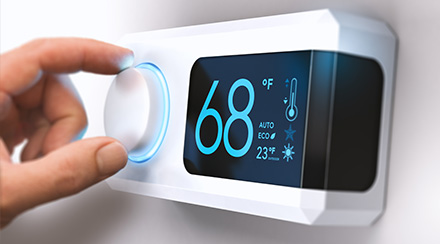How Many Watts Does a TV Use?

The television is the centerpiece of many American living rooms. And with the arrival of Internet-connected smart TVs, we’re using them to do more than ever before, like watch streaming video, listen to Internet radio and even shop online. So how much energy is all this using – and how much is it costing you?
There are several ways to calculate your TV’s energy use or estimate the energy consumption of a TV you’re thinking about buying. And while those figures can vary significantly by model, the good news is that most modern TVs will consume less than $50 in electricity per year for the typical user, often significantly less.
How Much Electricity Do TVs Use?
The most helpful starting data point for calculating a TV’s energy consumption is its wattage. According to the U.S. Department of Energy’s Energy Sage program, most modern TVs use somewhere between 50 and 200 watts of electricity.
To identify the wattage of a TV you own, check the back of the TV for an information label. Depending on the model, this may be a sticker, a stamped metal plate or laser printing directly on the TV itself. Wattage is expressed as a number followed by a capital “W.” If you’re shopping for a new TV at retail, you should be able to find this information on the box. When shopping online, read the product details carefully; if you don’t see the wattage listed at the point of purchase, you should be able to find it by looking up the same model on the TV manufacturer’s website.
How Many Watts Does a TV Use Per Hour?
Once you know your TV’s wattage, you can calculate your model’s overall electricity consumption and energy costs. To do this, you’ll need to estimate the average number of hours per day that your TV is in use.
Simply multiply your TV’s wattage by the number of hours you use it each day to get the watt-hours, then divide that number by 1000 to convert it to kilowatt-hours (kWh). The result is your TV’s typical daily energy consumption in kWh, the same unit of energy measurement you’ll find on your electricity bill.
Let’s assume your TV uses 75W of electricity and you use it for three hours per day:
75W x 3 = 225 watt-hours
225W ÷ 1000 = .225 kWh
This TV therefore consumes about .225 kWh per day, which is equivalent to 1.575 kWh per week or 82.125 kWh per year. You can then calculate your estimated electricity costs based on your kWh rate, which you can find on your monthly bill. Assuming your rate is 13 cents, this TV’s costs come out to about three cents per day, 20 cents per week and $10.65 per year.
What Else Can Affect TV Energy Consumption?

Even if you know your TV’s exact wattage and tend to stick to the same TV watching schedule, the energy usage you calculate may not match the reality exactly. That’s because there are several factors that can affect the actual amount of electricity your TV consumes. Here are some of the most significant variables:
- Screen brightness. This can have a dramatic effect on the true amount of electricity a TV is using. The higher the brightness, the higher the energy use. To save energy, try to keep the brightness at the lowest setting that allows you to clearly see what’s on the screen. Some TVs are equipped with sensors that can automatically adjust the brightness based on light levels in the room.
- Quick startup. Many TVs have a “quick startup” setting that allows a TV to turn on slightly faster than it would otherwise. The tradeoff is that TVs use slightly more energy in standby mode when this setting is turned on. If you don’t mind waiting an extra couple of seconds for your TV to start, you can save some energy by turning this feature off.
- Heat. Some TVs produce more heat than others, and higher heat levels often lead to higher electricity consumption. To help minimize this, make sure the area around your TV is well ventilated, and locate your TV away from sunny, unshaded windows.
- Running time. Leaving your TV on when you’re not using it simply wastes energy. If you have a bad habit of leaving the TV on, check the settings menu for a sleep timer that can automatically turn it off for you.
The specific type of TV you have can also affect the amount of energy it uses. Most TVs manufactured today are LED (light-emitting diode) or OLED (organic light-emitting diode). These types are comparable in terms of energy consumption, though OLED TVs use more energy on average.
Older TVs, like plasma TVs and CRT (cathode ray tube) TVs, consume significantly more electricity than modern TVs. Plasma was once a popular alternative to CRT technology due to its higher picture quality, but its energy demands are enormous. And before plasma came along, virtually every TV was a CRT, which also consumes several times the amount of electricity of a LED or OLED TV. If you’re using one of these older sets, you can save a bundle on energy costs by upgrading.
Other Ways to Measure and Estimate TV Energy Use
If you’re in the market for a new TV, keep an eye out for “EnergyGuide” labels. These labels are black and bright yellow, and TV manufacturers are required by law to make them available for every new TV they sell. EnergyGuide labels provide estimated annual operating costs at a glance, and because these labels are based on standardized kWh prices and duration-of-use estimates, they make it easy to compare the energy efficiency of different TV models.
If you want the most accurate electricity consumption data possible, you can also invest in an electricity usage monitor. These devices are as easy to connect as plugging your TV into a power strip, and they’ll display your TV’s real-time electricity consumption. So if you’re curious about just how big a difference it makes when you adjust your screen brightness or use certain smart TV apps, an electricity usage monitor will put that data at your fingertips.
Looking to save energy around your home and lower your monthly bills? Check out our favorite energy-saving tips.
Looking for Something Specific?
Select a category to find resources for topics that interest you.
Select Category

Related Articles:

Tips for Improving Your AC and Furnace Efficiency
We share maintenance tips for your heater and AC, and home improvement tips to help you use those systems less.
Read Article
Tips for Saving on Energy in Your Home
If you’re looking to learn more about energy efficiency for home systems and appliances, we’re sharing our favorite energy-saving tips.
Read Article
What Uses the Most Electricity In a Home?
We break down what uses the most energy in your home to give you an understanding of where your energy usage goes and where energy-saving tactics can make the most impact.
Read ArticleMost Popular Articles

Energy Plans to Fit Your Lifestyle
NRG offers electricity and natural gas plans with perks like cash back, travel rewards and more, so you can find a plan that fits your home and family.
How Many Watts Does a TV Use?
The television is the centerpiece of many American living rooms. And with the arrival of Internet-connected smart TVs, we’re using them to do more than ever before, like watch streaming video, listen to Internet radio and even shop online. So how much energy is all this using – and how much is it costing you?
There are several ways to calculate your TV’s energy use or estimate the energy consumption of a TV you’re thinking about buying. And while those figures can vary significantly by model, the good news is that most modern TVs will consume less than $50 in electricity per year for the typical user, often significantly less.
How Much Electricity Do TVs Use?
The most helpful starting data point for calculating a TV’s energy consumption is its wattage. According to the U.S. Department of Energy’s Energy Sage program, most modern TVs use somewhere between 50 and 200 watts of electricity.
To identify the wattage of a TV you own, check the back of the TV for an information label. Depending on the model, this may be a sticker, a stamped metal plate or laser printing directly on the TV itself. Wattage is expressed as a number followed by a capital “W.” If you’re shopping for a new TV at retail, you should be able to find this information on the box. When shopping online, read the product details carefully; if you don’t see the wattage listed at the point of purchase, you should be able to find it by looking up the same model on the TV manufacturer’s website.
How Many Watts Does a TV Use Per Hour?
Once you know your TV’s wattage, you can calculate your model’s overall electricity consumption and energy costs. To do this, you’ll need to estimate the average number of hours per day that your TV is in use.
Simply multiply your TV’s wattage by the number of hours you use it each day to get the watt-hours, then divide that number by 1000 to convert it to kilowatt-hours (kWh). The result is your TV’s typical daily energy consumption in kWh, the same unit of energy measurement you’ll find on your electricity bill.
Let’s assume your TV uses 75W of electricity and you use it for three hours per day:
75W x 3 = 225 watt-hours
225W ÷ 1000 = .225 kWh
This TV therefore consumes about .225 kWh per day, which is equivalent to 1.575 kWh per week or 82.125 kWh per year. You can then calculate your estimated electricity costs based on your kWh rate, which you can find on your monthly bill. Assuming your rate is 13 cents, this TV’s costs come out to about three cents per day, 20 cents per week and $10.65 per year.
What Else Can Affect TV Energy Consumption?
Even if you know your TV’s exact wattage and tend to stick to the same TV watching schedule, the energy usage you calculate may not match the reality exactly. That’s because there are several factors that can affect the actual amount of electricity your TV consumes. Here are some of the most significant variables:
- Screen brightness. This can have a dramatic effect on the true amount of electricity a TV is using. The higher the brightness, the higher the energy use. To save energy, try to keep the brightness at the lowest setting that allows you to clearly see what’s on the screen. Some TVs are equipped with sensors that can automatically adjust the brightness based on light levels in the room.
- Quick startup. Many TVs have a “quick startup” setting that allows a TV to turn on slightly faster than it would otherwise. The tradeoff is that TVs use slightly more energy in standby mode when this setting is turned on. If you don’t mind waiting an extra couple of seconds for your TV to start, you can save some energy by turning this feature off.
- Heat. Some TVs produce more heat than others, and higher heat levels often lead to higher electricity consumption. To help minimize this, make sure the area around your TV is well ventilated, and locate your TV away from sunny, unshaded windows.
- Running time. Leaving your TV on when you’re not using it simply wastes energy. If you have a bad habit of leaving the TV on, check the settings menu for a sleep timer that can automatically turn it off for you.
The specific type of TV you have can also affect the amount of energy it uses. Most TVs manufactured today are LED (light-emitting diode) or OLED (organic light-emitting diode). These types are comparable in terms of energy consumption, though OLED TVs use more energy on average.
Older TVs, like plasma TVs and CRT (cathode ray tube) TVs, consume significantly more electricity than modern TVs. Plasma was once a popular alternative to CRT technology due to its higher picture quality, but its energy demands are enormous. And before plasma came along, virtually every TV was a CRT, which also consumes several times the amount of electricity of a LED or OLED TV. If you’re using one of these older sets, you can save a bundle on energy costs by upgrading.
Other Ways to Measure and Estimate TV Energy Use
If you’re in the market for a new TV, keep an eye out for “EnergyGuide” labels. These labels are black and bright yellow, and TV manufacturers are required by law to make them available for every new TV they sell. EnergyGuide labels provide estimated annual operating costs at a glance, and because these labels are based on standardized kWh prices and duration-of-use estimates, they make it easy to compare the energy efficiency of different TV models.
If you want the most accurate electricity consumption data possible, you can also invest in an electricity usage monitor. These devices are as easy to connect as plugging your TV into a power strip, and they’ll display your TV’s real-time electricity consumption. So if you’re curious about just how big a difference it makes when you adjust your screen brightness or use certain smart TV apps, an electricity usage monitor will put that data at your fingertips.
Looking to save energy around your home and lower your monthly bills? Check out our favorite energy-saving tips.
Looking for Something Specific?
Select a category to find resources for topics that interest you.
Select Category

Related Articles:

Tips for Improving Your AC and Furnace Efficiency
We share maintenance tips for your heater and AC, and home improvement tips to help you use those systems less.
Read Article
Tips for Saving on Energy in Your Home
If you’re looking to learn more about energy efficiency for home systems and appliances, we’re sharing our favorite energy-saving tips.
Read Article
What Uses the Most Electricity In a Home?
We break down what uses the most energy in your home to give you an understanding of where your energy usage goes and where energy-saving tactics can make the most impact.
Read ArticleMost Popular Articles

Energy Plans to Fit Your Lifestyle
NRG offers electricity and natural gas plans with perks like cash back, travel rewards and more, so you can find a plan that fits your home and family.







